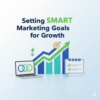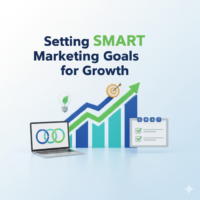How to Improve Your Content Marketing for Lead Generation Strategy
Published: 30 Sep 2025
Tired of draining your budget on expensive ads? The solution lies in strategic content marketing for lead generation. When executed effectively, content doesn’t just draw in passive traffic—it transforms visitors into valuable, high-quality leads who are already interested in your solutions.
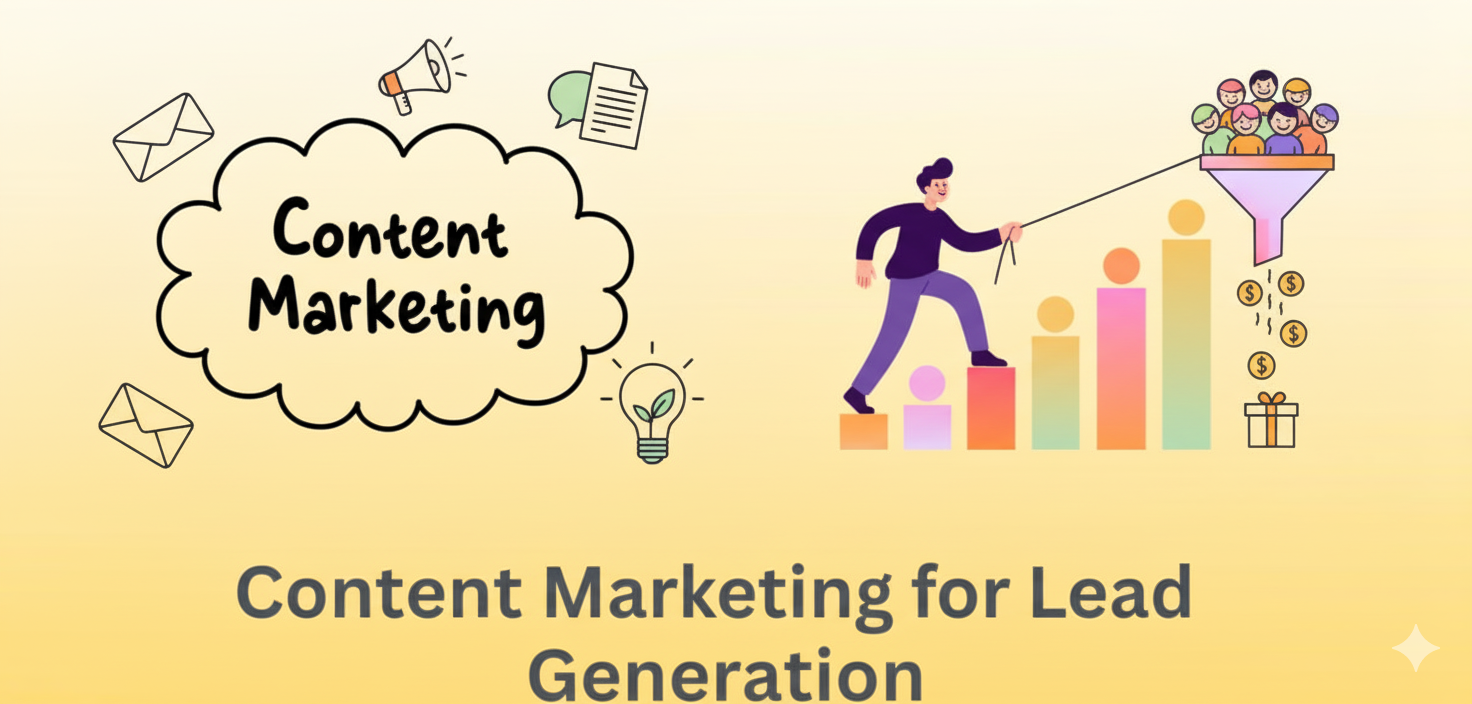
Lead generation is the process of capturing the attention of potential customers and guiding them toward taking actions that benefit your business, like signing up for a newsletter or making a purchase. And content marketing is the perfect tool for this. It educates, builds trust, and nurtures leads through every step of the buyer’s journey.
In this article, you’ll discover proven strategies and actionable tips to improve your content marketing and drive real results. From crafting content that resonates with your audience to optimizing for conversions, we’ll cover everything you need to know to turn your content into a lead-generation powerhouse. Ready to learn how to attract and convert high-quality leads?
Why Your Business Needs a Content Marketing Strategy for Lead Generation
A content marketing strategy is no longer optional in today’s competitive market. It’s a must-have for businesses that want to generate consistent, high-quality leads. Without a clear plan, your content efforts can easily fall flat, wasting time and resources.
A well-thought-out strategy helps you create content that resonates with your target audience, builds trust, and nurtures leads. This approach is essential for sustainable lead generation. By consistently offering valuable content, you ensure potential customers stay engaged and move closer to purchasing.
Here are some key benefits of having a content marketing strategy for lead generation:
- Increased Brand Awareness: High-quality content attracts more visitors, exposing your brand to a wider audience.
- Better Targeting: With a clear strategy, you can create content tailored to specific buyer personas, ensuring you reach the right people.
- Higher Conversion Rates: By offering valuable content at the right stage of the buyer’s journey, you can encourage visitors to take action, like signing up or purchasing.
For example, a software company created detailed blog posts about solving common issues their target audience faced. These posts boosted their organic traffic and helped convert visitors into leads. Over time, their content marketing for lead generation helped them build a steady pipeline of qualified prospects.
Without a strategy, your efforts might be scattered. But with the right plan, content can become a powerful tool to attract, nurture, and convert leads.
How to Develop a Lead-Generating Content Strategy
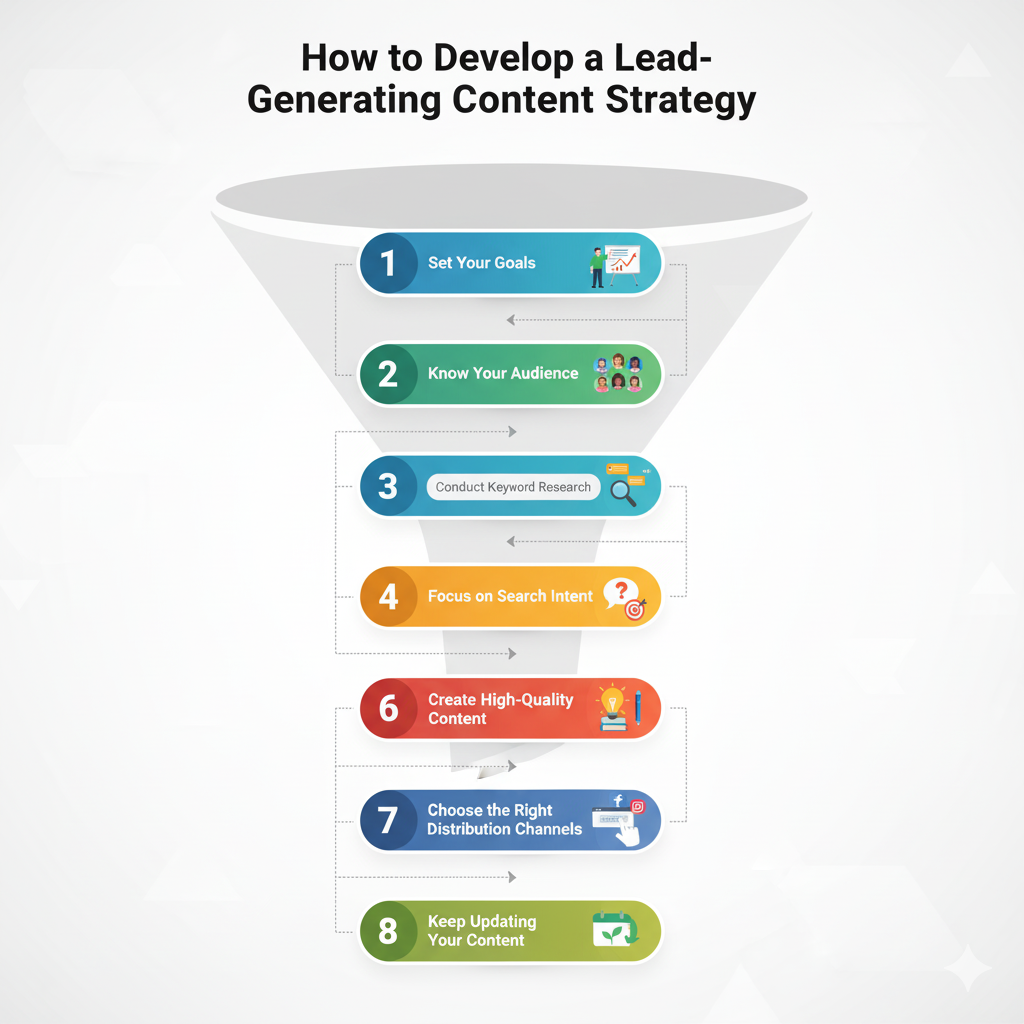
Creating a solid content strategy is key to generating high-quality leads. Here’s how to develop a plan that works:
1. Set Your Goals
Start by defining clear, measurable goals. Without them, it’s hard to know if your strategy is working.
Example: Set specific goals like “Increase email sign-ups by 15% in the next 3 months” or “Grow organic traffic by 20% in 6 months.”
These goals give you direction and focus.
2. Know Your Audience
Understanding your audience is crucial. You can’t create content that resonates if you don’t know who you’re talking to.
Persona Development: Create buyer personas to guide your content creation.
Tip: Use tools like Google Analytics and surveys to better understand your audience’s needs and pain points.
3. Conduct Keyword Research
Keyword research helps you create content that’s both relevant and searchable.
You can ensure the right people find your content by identifying the right keywords.
Focus Keyword: Include “Content Marketing for Lead Generation” to improve your SEO rankings.
4. Focus on Search Intent
Search intent is what users want when they search for something. It can be informational, navigational, or transactional.
Why it matters: Tailoring your content to match search intent increases the chance of converting visitors into leads.
5. Create High-Quality Content
Content should be valuable, informative, and engaging. High-quality content helps build trust with your audience.
Focus on solving problems and answering questions your audience has. The more helpful your content, the more likely it is to attract leads.
6. Optimize Your Content for Conversions
Simply creating content isn’t enough—you need to guide users to take action.
Call-to-Action (CTA): Include strong CTAs to lead users to the next step, such as downloading a guide or signing up for a newsletter.
7. Choose the Right Distribution Channels
Your content should reach your audience where they spend their time.
Channels: Distribute your content using platforms like your website, social media, and email. Tailor your approach based on where your audience is most active.
8. Keep Updating Your Content
Content needs to stay fresh. Regular updates keep your content relevant and engaging.
Conduct regular audits to identify which content needs a refresh or improvement to continue attracting leads.
Following these steps, you can develop a comprehensive, lead-generating content strategy that helps grow your business.
Understanding the Lead Generation Funnel and Its Stages
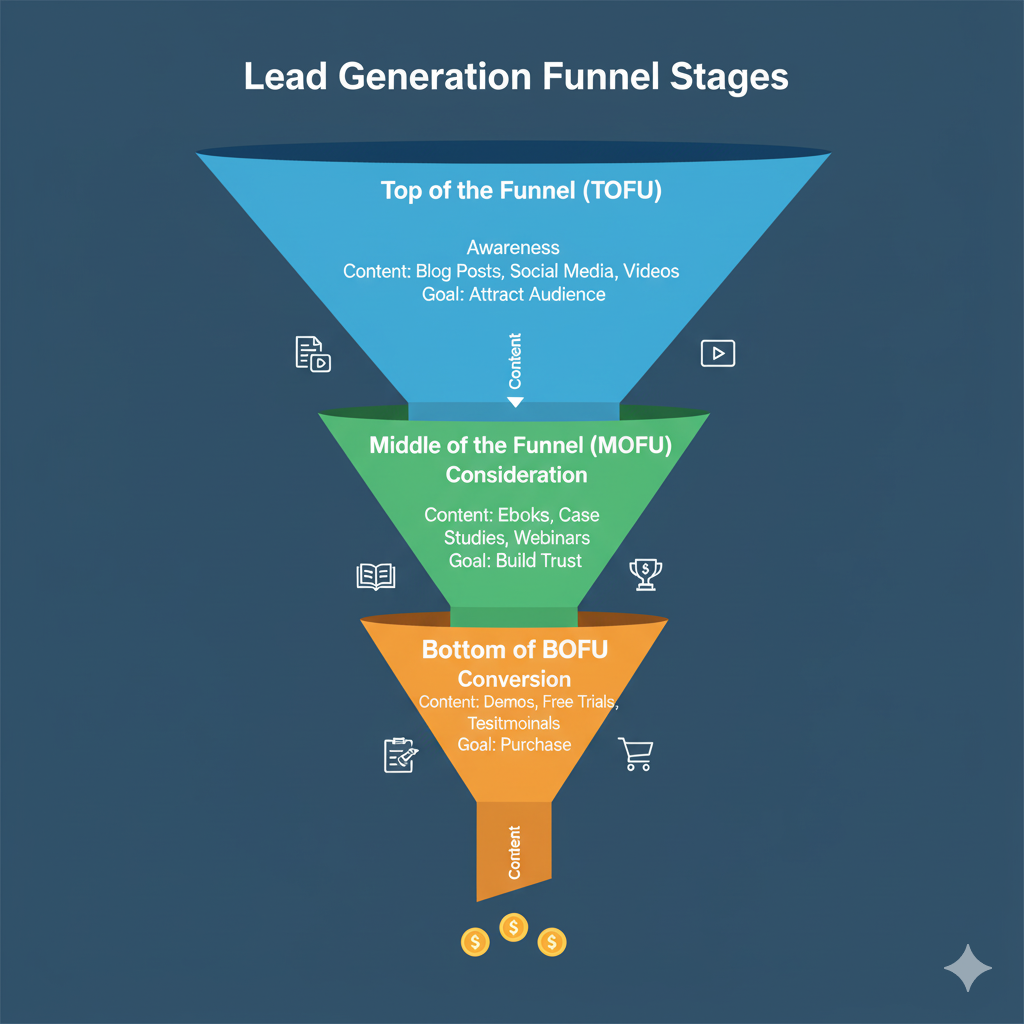
A lead generation funnel is a step-by-step process that guides potential customers from awareness to conversion. Think of it as a journey where content is key in moving prospects closer to becoming paying customers. The funnel is divided into three main stages: the top of the Funnel (TOFU), the Middle of the Funnel (MOFU), and the Bottom of the Funnel (BOFU).
What Is a Lead Generation Funnel?
The lead generation funnel is the path potential customers take before making a decision. Your content builds trust at each stage and guides you to the next step.
- TOFU: Awareness
- MOFU: Consideration
- BOFU: Conversion
Why Content is Critical for Your Funnel
Content nurtures leads at every funnel stage, offering the right information when needed. It engages prospects, educates them, and persuades them to act.
Top of the Funnel (TOFU)
At this stage, your goal is to capture attention and raise awareness. Potential customers might not know about your brand yet, so the content here should focus on educating and informing.
- Content Types: Blog posts, social media updates, educational videos, and infographics.
- Goal: Draw in a large audience and make them aware of your brand.
Middle of the Funnel (MOFU)
At this stage, leads know about you and are now considering solutions. Content should dive deeper, helping prospects evaluate their options and understand how your solution fits.
- Content Types: eBooks, case studies, webinars, and comparison guides.
- Goal: Build trust and show why your product or service is the right choice.
Bottom of the Funnel (BOFU)
Your leads are almost ready to convert. Content at this stage should focus on persuading them to take the final step.
- Content Types: Product demos, free trials, customer testimonials, and special offers.
- Goal: Encourage leads to make a purchase or sign up.
By creating targeted content for each stage of the funnel, you’ll guide leads through the process and increase your chances of conversion. Content is the key to turning awareness into action.
Lead Generation Marketing Strategies That Work
You need the right strategies to generate leads successfully. Here are some proven marketing techniques to help you attract and convert potential customers.
Search Engine Optimization (SEO)
SEO is one of the most powerful tools for generating organic traffic. Here’s how to make it work for lead generation:
- Step #1: Define Keywords
- Start by researching and selecting the right keywords for your business. Use tools like Google Keyword Planner to find phrases your target audience is searching for.
- Step #2: Create Optimized Content
- Develop content around your chosen keywords, ensuring it’s high-quality and informative. Use your keywords naturally in titles, headers, and throughout the body.
- Step #3: Offer a Lead Magnet
- Offer something valuable, like a free guide, checklist, or eBook, to encourage visitors to take action. This helps convert traffic into leads.
LinkedIn Advertising
For B2B businesses, LinkedIn is a goldmine for lead generation. It offers advanced targeting options that can help you reach the decision-makers in your industry.
- Why LinkedIn is Effective for B2B Lead Generation: LinkedIn allows you to target people based on job titles, industries, and company sizes, making it perfect for B2B campaigns.
- Best Practices:
- Craft highly engaging ads that speak directly to your audience’s pain points.
- Clear CTAs to drive conversions, like “Request a demo” or “Download our whitepaper.”
Co-Marketing
Co-marketing involves partnering with another business to create and share content that benefits both parties. This strategy expands your reach and attracts new leads.
- Step #1: Find the Right Co-Marketing Partners
- Look for businesses with complementary offerings and similar target audiences.
- Step #2: Share Content and Drive Mutual Value
- Collaborate to create content you can share on your respective platforms.
- Step #3: Promote Each Other’s Content
- By promoting each other’s content, you tap into each other’s audience and expand your reach.
Email Marketing
Email marketing is one of the most effective ways to nurture and move leads down the sales funnel.
- Nurture Leads Through Email: Use personalized email campaigns to build relationships and keep your leads engaged.
- Automate Follow-up Sequences: Set up automated emails to send at key stages, like after a lead signs up or downloads a resource.
- Tip: Segment your email list based on factors like engagement, interests, and demographics to increase conversion rates.
By using these strategies, you’ll attract more leads and improve your ability to nurture them into loyal customers.
Proven Lead Generation Techniques and Examples
To effectively generate leads, you must implement proven techniques that capture and engage visitors. Here are some methods that work:
1. Email Capture Forms
Email capture forms are one of the most effective ways to gather leads. But to make them work, you need to follow best practices:
- Where and How to Place Forms: Position forms in high-visibility areas such as the top of your website or at the end of blog posts.
- Minimalistic Design: Keep forms simple. Ask for only the essentials, like name and email address. This reduces friction and encourages more sign-ups.
- Tips:
- Use conditional logic to display fields only when necessary.
- Engage users by offering something in return, such as a free download or discount.
- Avoid overwhelming users with too many fields—keep it simple!
2. Live Chat and Chatbots
Live chat and chatbots are powerful tools for engaging visitors in real time and capturing leads instantly. They allow you to address questions, offer assistance, and convert visitors into leads while they’re still on your website.
- How it Works: A chatbot can prompt users with helpful questions, gather information, and guide them toward the next steps in your funnel.
- Example: A SaaS company used a chatbot to collect email addresses from visitors looking for a demo instantly. This tool increased lead capture by 25% over three months.
3. Website Visitor Identification
Some tools can identify anonymous visitors and help you capture leads effectively. These tools track visitor behaviour and gather data about your site’s visitors.
- How It Works: Using tools like LeadFeeder or Albacross lets you see which companies visit your website. Then, you can retarget them with tailored ads or personalized outreach.
- This technique helps you turn anonymous traffic into valuable leads.
Integrating these techniques into your lead generation strategy will create more opportunities to capture, engage, and convert potential customers.
Measuring and Optimizing Content Marketing for Lead Generation
To ensure your content marketing efforts drive results, you must continuously measure performance and optimize your strategy. Here’s how to do it:
Track Key Metrics
Monitoring key metrics helps you understand how well your content is performing. Focus on the following:
- Traffic: How many people are visiting your website or landing pages?
- Conversions: How many visitors are turning into leads by filling out forms, downloading resources, or signing up?
- Engagement: Are users interacting with your content (e.g., comments, shares, time spent on the page)?
- These metrics give you insight into what’s working and where to improve.
Refining Your Strategy
Once you have data, use it to refine and optimize your approach. If certain content types drive more conversions, create more of them. If traffic is high but conversions are low, tweak your calls-to-action or forms.
- A/B Testing: Experiment with headlines, CTAs, or layouts to see what resonates most with your audience.
- Feedback Loops: Gather feedback from your leads or customers about what content they found helpful, and adjust your content strategy accordingly.
Tools for Measuring Performance
To track your progress and fine-tune your content marketing, use tools like:
- Google Analytics: Monitor website traffic, user behaviour, and conversion rates.
- HubSpot: Analyze lead conversion, email performance, and overall content engagement.
- SEMrush: Evaluate SEO performance and identify opportunities for improvement.
Regularly measuring and optimizing your content marketing efforts can improve your lead generation results and ensure your strategy stays on track.
Final Remarks
A targeted content marketing strategy is essential for driving high-quality leads in today’s competitive landscape. You can successfully nurture and convert leads by setting clear goals, understanding your audience, optimizing for SEO, and delivering valuable content at every stage of the funnel. Regularly measuring performance and refining your approach ensures continuous improvement.
Now is the time to take action. Review your current content strategy, apply the tips and tactics from this article, and watch your lead generation efforts grow. Implementing these strategies will help you attract, engage, and convert more leads, ultimately leading to business growth.
FAQs
Focus on organic strategies like SEO, content repurposing, and leveraging social media platforms. Create valuable content that answers common questions and promote it through low-cost channels like email newsletters and partnerships.
Create content that addresses the pain points of your target audience. Blog posts, case studies, webinars, and eBooks are all great ways to provide value and capture qualified leads.
Track metrics like website traffic, lead conversion rates, and customer lifetime value. Tools like Google Analytics and HubSpot can help you measure the performance and ROI of your content efforts.

- Be Respectful
- Stay Relevant
- Stay Positive
- True Feedback
- Encourage Discussion
- Avoid Spamming
- No Fake News
- Don't Copy-Paste
- No Personal Attacks

- Be Respectful
- Stay Relevant
- Stay Positive
- True Feedback
- Encourage Discussion
- Avoid Spamming
- No Fake News
- Don't Copy-Paste
- No Personal Attacks
